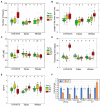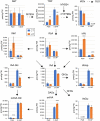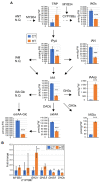Long-Term High-Temperature Stress Impacts on Embryo and Seed Development in Brassica napus
- PMID: 35528932
- PMCID: PMC9075611
- DOI: 10.3389/fpls.2022.844292
Long-Term High-Temperature Stress Impacts on Embryo and Seed Development in Brassica napus
Abstract
Brassica napus (rapeseed) is the second most important oilseed crop worldwide. Global rise in average ambient temperature and extreme weather severely impact rapeseed seed yield. However, fewer research explained the phenotype changes caused by moderate-to-high temperatures in rapeseed. To investigate these events, we determined the long-term response of three spring cultivars to different temperature regimes (21/18°C, 28/18°C, and 34/18°C) mimicking natural temperature variations. The analysis focused on the plant appearance, seed yield, quality and viability, and embryo development. Our microscopic observations suggest that embryonic development is accelerated and defective in high temperatures. Reduced viable seed yield at warm ambient temperature is due to a reduced fertilization rate, increased abortion rate, defective embryonic development, and pre-harvest sprouting. Reduced auxin levels in young seeds and low ABA and auxin levels in mature seeds may cause embryo pattern defects and reduced seed dormancy, respectively. Glucosinolates and oil composition measurements suggest reduced seed quality. These identified cues help understand seed thermomorphogenesis and pave the way to developing thermoresilient rapeseed.
Keywords: Brassica napus; embryo development; high temperatures; hormonal profiling; oil content; seed development; thermomorphogenesis.
Copyright © 2022 Mácová, Prabhullachandran, Štefková, Spyroglou, Pěnčík, Endlová, Novák and Robert.
Conflict of interest statement
The authors declare that the research was conducted in the absence of any commercial or financial relationships that could be construed as a potential conflict of interest.
Figures









Similar articles
-
Transcriptome analysis of thermomorphogenesis in ovules and during early seed development in Brassica napus.BMC Genomics. 2023 May 4;24(1):236. doi: 10.1186/s12864-023-09316-2. BMC Genomics. 2023. PMID: 37142980 Free PMC article.
-
Heat stress during seed filling interferes with sulfur restriction on grain composition and seed germination in oilseed rape (Brassica napus L.).Front Plant Sci. 2015 Apr 10;6:213. doi: 10.3389/fpls.2015.00213. eCollection 2015. Front Plant Sci. 2015. PMID: 25914702 Free PMC article.
-
Dynamics of seed dormancy and germination at high temperature stress is affected by priming and phytohormones in rapeseed (Brassica napus L.).J Plant Physiol. 2022 Feb;269:153614. doi: 10.1016/j.jplph.2021.153614. Epub 2021 Dec 28. J Plant Physiol. 2022. PMID: 34979489
-
Integration of omics approaches to understand oil/protein content during seed development in oilseed crops.Plant Cell Rep. 2017 May;36(5):637-652. doi: 10.1007/s00299-016-2064-1. Epub 2016 Oct 27. Plant Cell Rep. 2017. PMID: 27796489 Review.
-
Genetic and molecular approaches to improve nutritional value of Brassica napus L. seed.C R Biol. 2008 Oct;331(10):763-71. doi: 10.1016/j.crvi.2008.07.018. Epub 2008 Sep 4. C R Biol. 2008. PMID: 18926490 Review.
Cited by
-
Transcriptomic analysis of rapeseed (Brassica napus. L.) seed development in Xiangride, Qinghai Plateau, reveals how its special eco-environment results in high yield in high-altitude areas.Front Plant Sci. 2022 Aug 2;13:927418. doi: 10.3389/fpls.2022.927418. eCollection 2022. Front Plant Sci. 2022. PMID: 35982704 Free PMC article.
-
Heat stress during reproductive stages reduces camelina seed productivity and changes seed composition.Heliyon. 2024 Feb 19;10(4):e26678. doi: 10.1016/j.heliyon.2024.e26678. eCollection 2024 Feb 29. Heliyon. 2024. PMID: 38434085 Free PMC article.
-
Heat stress during seed development leads to impaired physiological function and plasticity in seed oil accumulation in Camelina sativa.Front Plant Sci. 2023 Nov 24;14:1284573. doi: 10.3389/fpls.2023.1284573. eCollection 2023. Front Plant Sci. 2023. PMID: 38078110 Free PMC article.
-
Heat-Stress-Induced Changes in Physio-Biochemical Parameters of Mustard Cultivars and Their Role in Heat Stress Tolerance at the Seedling Stage.Plants (Basel). 2023 Mar 21;12(6):1400. doi: 10.3390/plants12061400. Plants (Basel). 2023. PMID: 36987087 Free PMC article.
-
Streamlining YOLOv7 for Rapid and Accurate Detection of Rapeseed Varieties on Embedded Device.Sensors (Basel). 2024 Aug 28;24(17):5585. doi: 10.3390/s24175585. Sensors (Basel). 2024. PMID: 39275496 Free PMC article.
References
-
- Aksouh-Harradj N. M., Campbell L. C., Mailer R. J. (2006). Canola response to high and moderately high temperature stresses during seed maturation. Can. J. Plant Sci. 86, 967–980. doi: 10.4141/p05-130 - DOI
-
- Andersen C. L., Jensen J. L., Ørntoft T. F. (2004). Normalization of real-time quantitative reverse transcription-PCR data: a model-based variance estimation approach to identify genes suited for normalization, applied to bladder and colon cancer data sets. Cancer Res. 64, 5245–5250. doi: 10.1158/0008-5472.can-04-0496, PMID: - DOI - PubMed
-
- Angadi S. V., Cutforth H. W., Miller P. R., McConkey B. G., Entz M. H., Brandt S. A., et al. . (2000). Response of three brassica species to high temperature stress during reproductive growth. Can. J. Plant Sci. 80, 693–701. doi: 10.4141/P99-152 - DOI
-
- Annisa A., Chen S., Turner N. C., Cowling W. A. (2013). Genetic variation for heat tolerance during the reproductive phase in Brassica rapa. J. Agron. Crop Sci. 199, 424–435. doi: 10.1111/jac.12034 - DOI
LinkOut - more resources
Full Text Sources

